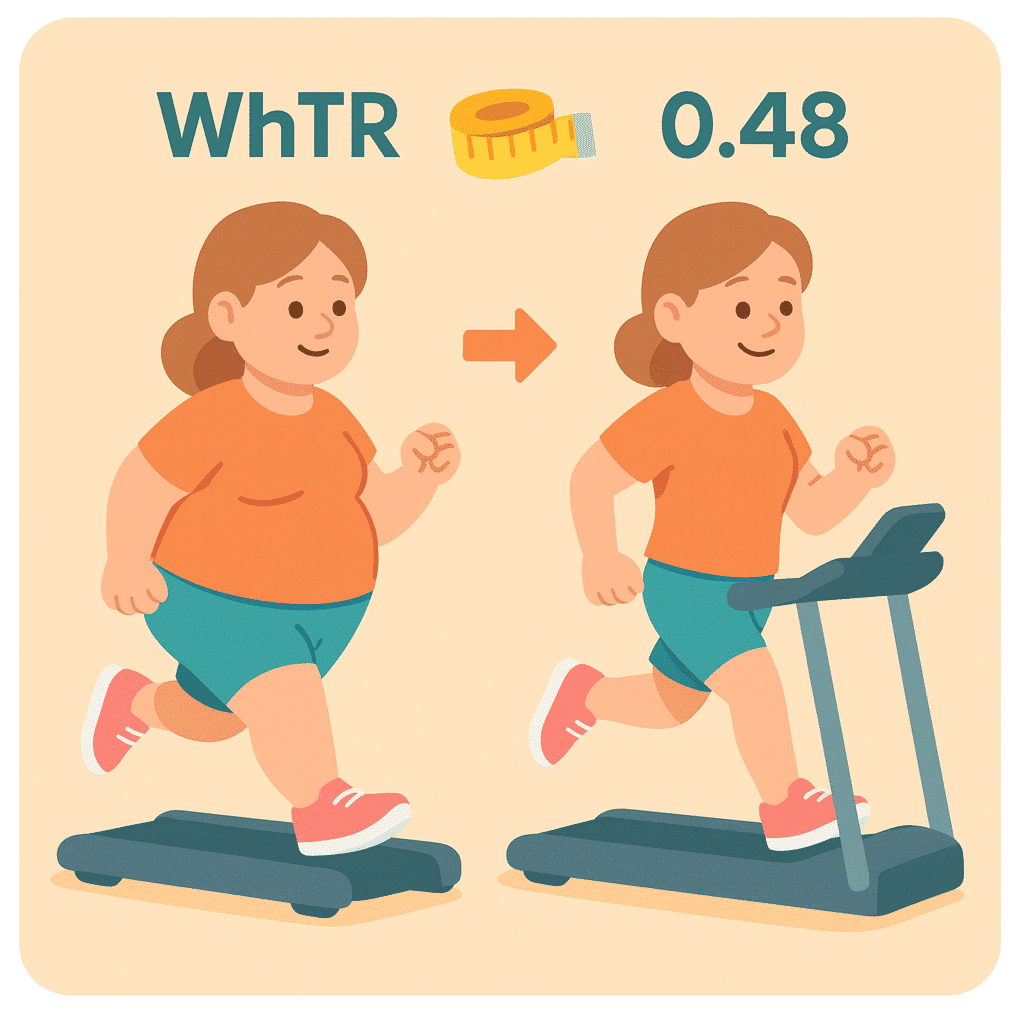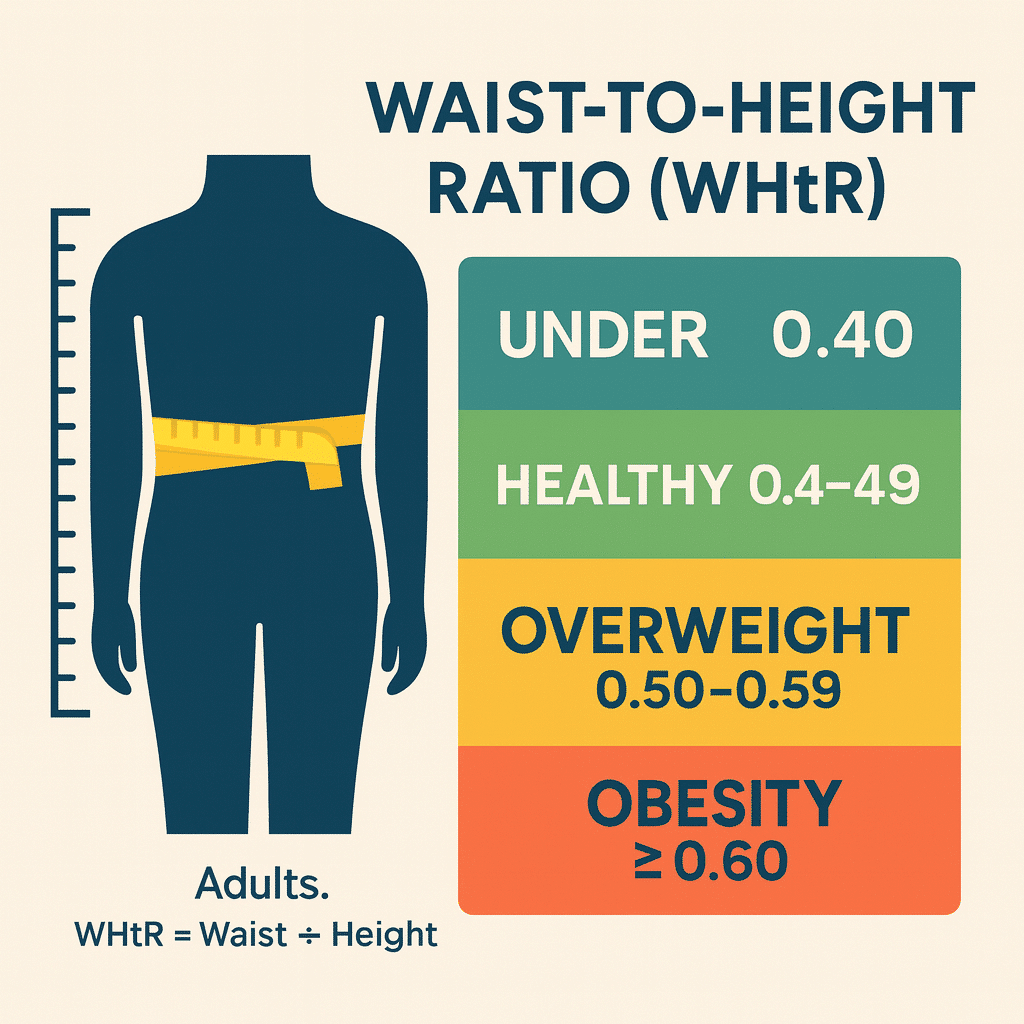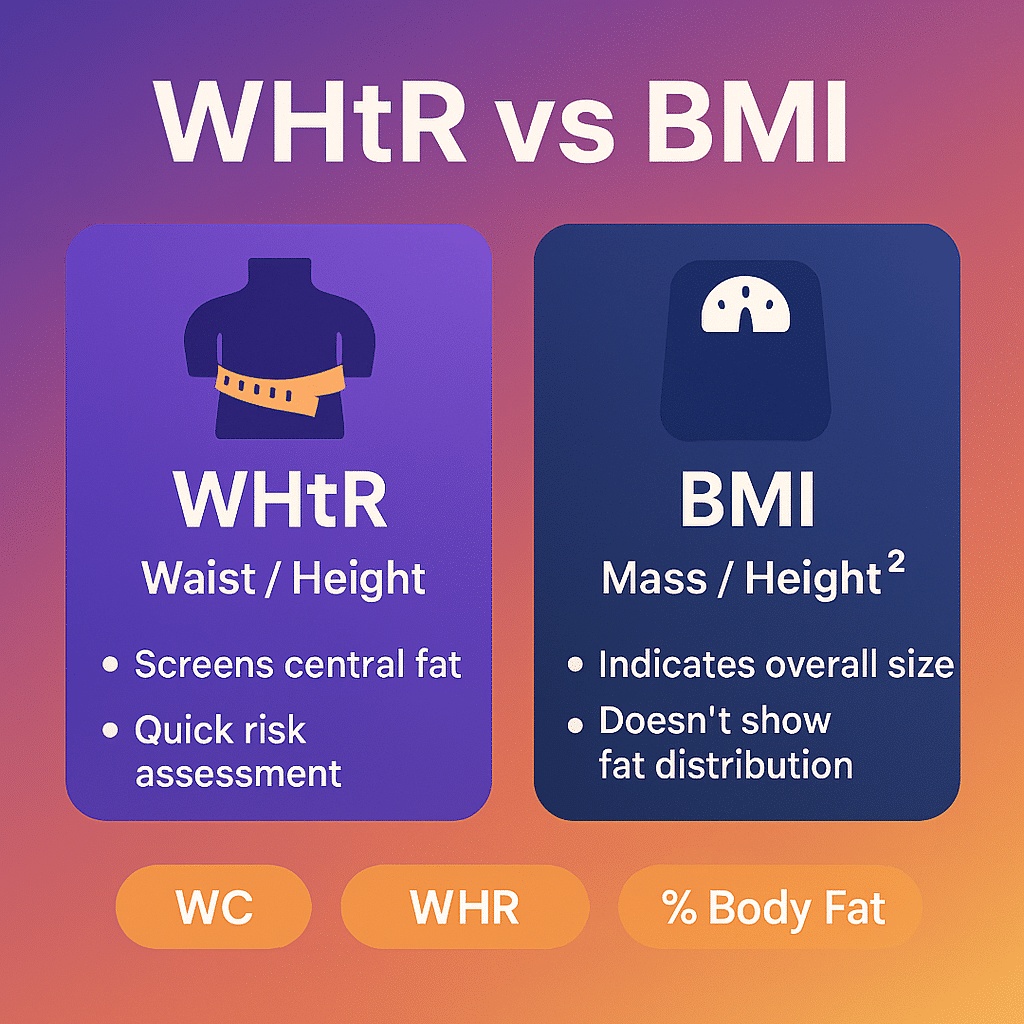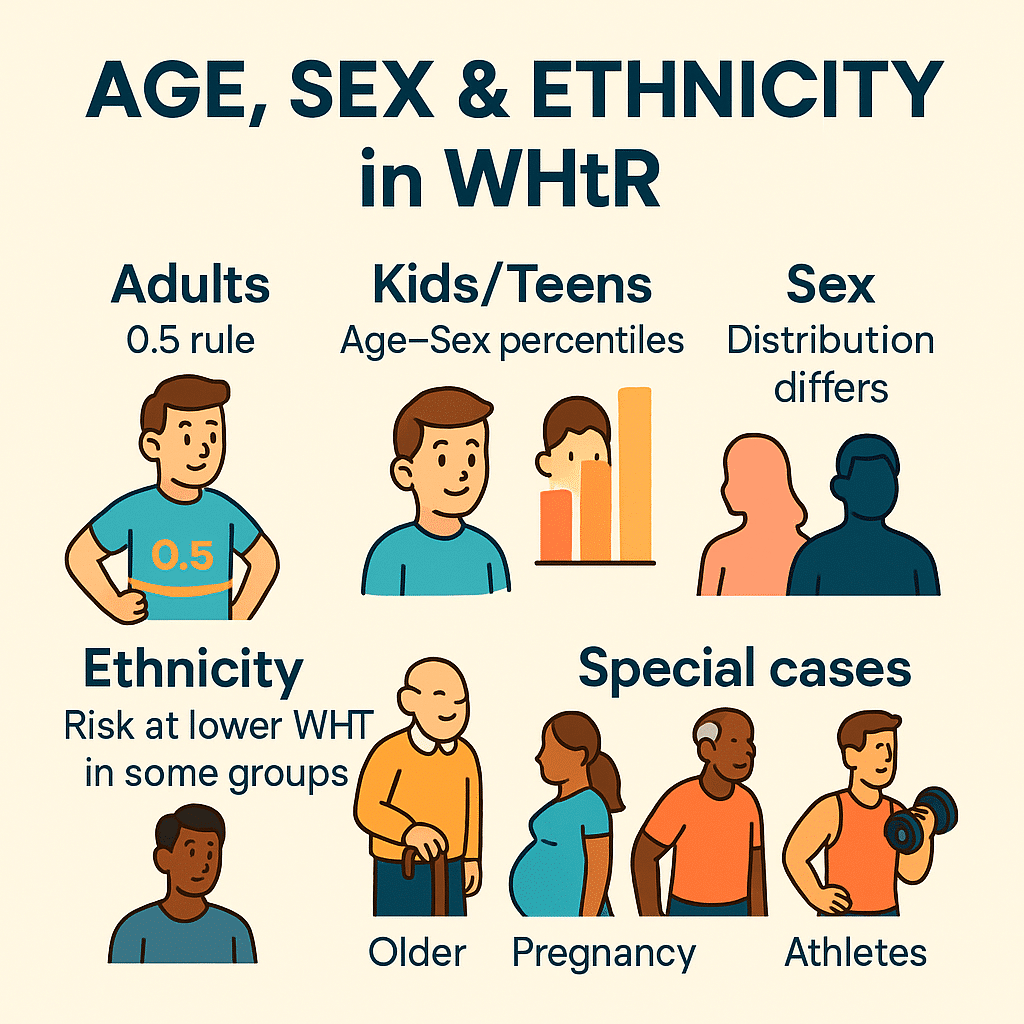Waist-to-Height Ratio (WHtR) Calculator
Pelank Life ©
Research indicates that the Waist-to-Height Ratio (WHtR) is useful for assessing abdominal obesity and the risk of cardiovascular-metabolic diseases. The “0.5 rule” is commonly recognized as a simple reference (for adults: it is recommended that the waist circumference be less than half of the height). However, the final interpretation should be considered in light of age, gender, and individual conditions, and it is not a substitute for medical diagnosis.
Waist-to-Height Ratio (WHtR)
A quick abdominal obesity indicator: keep waist less than half of height.
| Indicator | WHtR |
|---|---|
| Waist | — |
| Height | — |
| Ratio | — |
| Category | — |
Reference chart
Your current category is highlighted.
| WHtR Range | Category |
|---|---|
| < 0.40 | Under/Low risk |
| 0.40 – 0.49 | Healthy |
| 0.50 – 0.59 | Increased risk |
| ≥ 0.60 | High risk |
This tool does not replace professional medical advice.
Pelank Life | Body Health Assessment
The Best Body Health Calculators Using Scientific Methods
Developed by Pelank Life ©
Waist-to-Height Ratio (WHtR)
A Modern Tool for Health Assessment
Introduction
In today's world, measuring health and obesity status has become a major concern. Various indices are used to assess body condition, with the Body Mass Index (BMI) being one of the most important. However, despite its widespread use, the BMI index cannot assess abdominal obesity and internal fat, which can have a significant impact on human health. In this regard, the Waist-to-Height Ratio (WHtR) has emerged as a more accurate and practical metric. This article provides a detailed examination of this index, exploring its calculation, applications, advantages, and limitations.

What Makes WHtR Important?
One of the main concerns in public health is abdominal obesity. This type of obesity, caused by the accumulation of fat around the abdomen and vital organs (such as the heart and liver), increases the risk of metabolic and cardiovascular diseases. In this context, the WHtR serves as a modern tool that helps professionals better assess individuals’ health status.
Why Should We Pay Attention to Waist Circumference?
Waist circumference is a crucial factor in determining abdominal obesity. Abdominal fat, particularly visceral fat (fat inside the abdomen that surrounds internal organs), is a significant contributor to various diseases, including high blood pressure, type 2 diabetes, heart disease, and even certain types of cancer. Therefore, accurately measuring waist circumference can provide valuable insights into an individual’s health.
Difference from Other Obesity Measurement Indices
While Body Mass Index (BMI) is commonly used as a measure for assessing obesity, many studies have shown that BMI cannot accurately assess abdominal obesity. BMI only considers an individual’s weight and height, providing no information about the distribution of body fat. In contrast, the Waist-to-Height Ratio (WHtR), by factoring in waist circumference, can better reflect abdominal fat and assess metabolic risks with greater accuracy.
Connection with Diseases
Studies have shown that WHtR has a more direct correlation with the risk of metabolic diseases, high blood pressure, heart disease, and even premature death compared to BMI. In fact, individuals with a higher WHtR, even if they have a normal or low BMI, may be at greater risk.
How to Calculate WHtR
The WHtR calculator is obtained by dividing the waist circumference by height, and no complex equipment is needed for the calculation. The simple formula is as follows:

Standard Criteria
|
Underweight |
Healthy Weight |
Overweight |
Obesity |
|---|---|---|---|
|
WHtR less than 0.40 |
WHtR between 0.40 and 0.50 |
WHtR between 0.50 and 0.60 |
WHtR greater than 0.60 |
How to Measure Accurately
To measure waist circumference accurately, a flexible measuring tape should be used, placed around the abdomen near the navel without excessive pressure. Height should also be measured while standing in an upright position.
Examining the Applications of WHtR
In Preventive Medicine
WHtR is recognized as an effective tool for disease prevention. Healthcare professionals can use this index to identify individuals at risk of cardiovascular and metabolic diseases. Those with a higher WHtR need significant lifestyle changes, such as weight loss and improving their diet.
In Public Health Assessment
This index can help individuals better understand their health status. Even if a person’s BMI is normal, a WHtR higher than usual may indicate excess abdominal fat, which could lead to health problems.
In Scientific and Medical Research
In the medical world, WHtR is recognized as a more accurate and reliable index for assessing body health status. This index has been used in many research studies and scientific investigations as one of the key methods for examining abdominal obesity and its associated risks.
WHtR Compared to BMI and Other Obesity Metrics
Comparison of WHtR and BMI
While BMI is suitable for detecting general body obesity, it cannot accurately simulate abdominal obesity or visceral fat. In contrast, WHtR clearly focuses on abdominal fat distribution and can better predict the risks associated with this type of fat. Additionally, WHtR is more accurate than BMI in older individuals or those with strong muscles and naturally lower body fat.
Advantages of WHtR Over Other Indices
Higher accuracy in detecting abdominal obesity: WHtR can more accurately assess abdominal fat than BMI.
Simple and cost-effective: Its measurement is very straightforward and does not require complex equipment.
Easy to calculate: Anyone can easily calculate their WHtR.

Tips and Limitations of WHtR
Limitations
Although WHtR is one of the most accurate indices for measuring abdominal obesity, it may not be precise in cases such as individuals with specific body structures (e.g., those with large bone structures or athletic bodies). Additionally, the use of WHtR in children or older adults should be done with greater caution.
Impact of Gender and Age
The WHtR value may vary across different ages and genders. In general, men tend to have more abdominal fat than women, but in both genders, a higher WHtR indicates higher health risks.
Methods to Improve WHtR
Lifestyle Changes
The best method for reducing WHtR is to make positive lifestyle changes. These changes include improving diet, increasing physical activity, and reducing stress.
Weight Loss and Exercise Programs
To reduce abdominal fat and improve WHtR, exercise programs combining aerobic exercises (such as running, swimming, cycling) and strength training (such as weightlifting and bodybuilding) are recommended.
WHtR Thresholds
Based on Age, Gender, and Ethnicity + Guide for Children
Why Is This Section Important?
For adults, the “waist ≤ half of height (WHtR ≈ 0.5)” rule serves as a quick and reliable screening tool; however, for children and adolescents, age- and gender-specific percentiles should be used. Additionally, gender and ethnic differences can alter the risk at similar WHtR values, so interpretation should be context-based.

Adults: Practical Thresholds
Rule of Thumb: Keep your waist circumference below half of your height.
|
Underweight |
Healthy Weight |
Overweight |
Obesity |
|---|---|---|---|
|
WHtR less than 0.40 |
WHtR between 0.40 and 0.50 |
WHtR between 0.50 and 0.60 |
WHtR greater than 0.60 |
Quick Table "Height ↔ Maximum Waist Circumference (0.5 Rule)"
Measurement Note: Height should be measured barefoot and standing straight; waist circumference should be taken at the midpoint between the lower rib and the iliac crest (hip bone) or level with the navel—use the same method consistently.
|
Height (cm) |
Maximum Waist Circumference (cm) |
|---|---|
|
150 |
75 |
|
155 |
77.5 |
|
160 |
80 |
|
165 |
82.5 |
|
170 |
85 |
|
175 |
87.5 |
|
180 |
90 |
|
185 |
92.5 |
|
190 |
95 |
|
195 |
97.5 |
|
200 |
100 |
Gender Differences
Men typically store more visceral fat, while women store more peripheral fat (hips/thighs); however, 0.5 is applicable for both genders in adults. Some studies suggest a slightly lower threshold for women, but the clinical consensus for screening still revolves around 0.5.
Ethnic Differences
In some populations (e.g., South/East Asia and parts of the Middle East), metabolic risk may be high even at lower WHtR values; therefore, the range of 0.48–0.52 should be interpreted with more caution, while simultaneously assessing blood pressure, fasting glucose, lipids, and family history.
Children and Adolescents (5 to 19 years)
Use age- and gender-specific percentile charts for WHtR/WC.
“0.5” can be a warning sign, but it is not diagnostic.
Interpretation should be done alongside BMI-for-age, WC-for-age, and clinical findings.
In case of borderline results or the presence of risk factors, specialized assessment is recommended.
Special Cases
Elderly: Loss of height (kyphosis/osteoporosis) can seemingly increase WHtR. Measure current height accurately or use alternative methods (knee height).
Pregnancy: WHtR is not valid during pregnancy and early postpartum.
Athletes: BMI may mistake muscle for fat; WHtR is more useful for abdominal fat, but abdominal wall hypertrophy or temporary bloating can alter waist measurements.
Conclusion
If you are an adult: Aim for waist ≤ 0.5 × height.
For children/adolescents: Age-gender percentiles are the primary criteria for interpretation.
In high-risk populations and borderline values, complement the interpretation with other indices and tests.
Conclusion
The Waist-to-Height Ratio (WHtR) is a useful and accurate tool for assessing abdominal obesity and health risk evaluation. Due to its simplicity in calculation and higher accuracy compared to BMI, it has been widely used in many studies and medical fields. Individuals with a high WHtR should pay special attention to lifestyle changes to reduce the risks associated with abdominal fat and metabolic diseases.